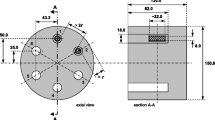Abstract.
The aim of this study was to evaluate the use of 124I positron emission tomography (PET) to determine the dosimetry of radioiodine therapy in hyperthyroidism and thyroid cancer. Phantom studies to assess the accuracy of PET were performed using an EEC phantom with spheres of different diameters filled with 3–30 MBq of 124I. Patient dosimetry was derived from PET data obtained 1–13 days after simultaneous oral administration of a therapeutic dose of 131I and a diagnostic dose of 124I. The obtained data were compared with findings from intratherapeutic probe measurements and clinical outcome. The phantom studies confirmed that 124I can be quantitated by PET (imprecision ≤10%), and volumetry is feasible for nodules <13 mm (imprecision ≤20%). Any influence of contamination with 123I or the simultaneous administration of 131I on the accuracy of the PET quantification and the probe measurements was ruled out by phantom measurements with solutions of 131I, 124I and123I in various ratios. In autonomous nodular goitres, radioiodine uptake measured by PET varied from 25.4% to 64.3% and was not significantly different from that obtained by a scintillation probe (24.1%–73.1%, correlation coefficient r=0.91). Comparison of uptake and effective half-life in normal tissue versus autonomous nodules revealed significant differences in uptake but not in effective half-life [uptake 2.0–8.3 kBq/(ml × MBq) in normal tissue vs 12.6–29.3 kBq/(ml × MBq) in nodules; half-life 97.8–156.7 h in normal tissue vs 73.3–192.3 h in nodules]. Calculated radiation doses ranged between 177 and 633 Gy for autonomous nodules and between 47 and 126 Gy for normal tissue. In thyroid cancer patients, doses between 350 and 1,420 Gy were achieved in thyroid remnants and between 70 and 170 Gy in tumour metastases. It is concluded that 124I and PET are suitable for evaluation of the dosimetry of radioiodine therapy in benign and malignant thyroid diseases. The applied technique might be particularly useful for quantitative dose-response studies in radioiodine treatment and further investigations of stunning phenomena.
Similar content being viewed by others
Author information
Authors and Affiliations
Corresponding author
Additional information
Received 23 August and in revised form 10 January 2002
Electronic Publication
Rights and permissions
About this article
Cite this article
Eschmann, S.M., Reischl, G., Bilger, K. et al. Evaluation of dosimetry of radioiodine therapy in benign and malignant thyroid disorders by means of iodine-124 and PET. Eur J Nucl Med 29, 760–767 (2002). https://doi.org/10.1007/s00259-002-0775-8
Published:
Issue Date:
DOI: https://doi.org/10.1007/s00259-002-0775-8




